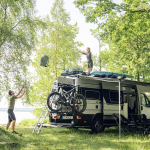The U.S. Department of Agriculture Forest Service made an official announcement last week stating that they will be implementing a rule to “conserve roadless areas in national forests through inviting input from state governors” in order to manage inventoried roadless areas. The official press release from the USDA states that the rule sets a “straightforward, collaborative path toward conserving inventoried roadless areas.”
“Our actions today advance President Bush's commitment to cooperatively conserve inventoried roadless areas within our national forests,” Agriculture Secretary Mike Johanns said. “USDA is committed to working closely with the nation's governors to meet the needs of our local communities.”
While this angle can make the rule sound like a step in the right direction, conservation groups and Outdoor Industry Association feel that it is simply masking the real issue. With this action, the federal government apparently wishes to step away from its role as a protector of natural resources and placed the burden on individual states. While the Forest Service is calling this “The New Roadless Rule,” many environmental groups have dubbed it, “The Treeless Rule.”
The Forest Service further states that this new rule “allows” governors to petition the Secretary of Agriculture to develop roadless regulations. The Forest Service will accept petitions from governors for 18 months while the Forest Service will maintain the current inventoried roadless areas. What the Forest Service fails to mention in their press release is that the rule requires governors to file the petition within the 18 months allotted, and once the deadline passes, the current roadless protections cease to exist. Additionally, the secretary of Agriculture at the Forest Service has the authority to deny any states petition.
“By formally repealing the Roadless Area Conservation Rule, the Bush administration is, yet again, doing its hardest to ignore over four million public comments in support of wild forest protection as well as an exceptionally strong ruling from the 9th Circuit Court of Appeals upholding the legality of the rule,” said Sean Cosgrove, National Forest Policy Specialist at Sierra Club. He called the new rule “a sham process” and an “unfunded mandate.”
The original roadless rule placed about one-third, or 58.5 million acres, of the national forest system's total acreage off-limits to virtually all road-building and logging. In 2001, the Bush Administration announced their support for President Clinton's roadless rule. Since then it seems the administration has changed their tune.
“We are greatly disappointed that the Administration has chosen a plan that could create dozens of individual rules rather than providing strong national guidance on protecting roadless forests,” said OIA president Frank Hugelmeyer in an OIA release.
The backlash to this rule does not appear to be partisan, with both Democrats and Republicans are speaking out against this unilateral action. Jim DiPeso, Policy Director for REP America, the national grassroots organization of Republicans for Environmental Protection, said, “The first rule of fiscal responsibility is to stop digging when youre in a hole At a time when the Forest Service has a $10 billion roads maintenance backlog and when it is closing campgrounds and other recreation sites nationwide, it makes no sense for the Forest Service to build more roads that it cant afford. The taxpayers shouldnt have to put up with such reckless mismanagement.”
The Natural Resources Defense Council echoes these sentiments, pointing to the economic benefits of maintaining these few existing roadless areas. NRDC Senior Attorney Niel Lawrence said, “These forests are worth more to our economy standing than stacked as two-by-fours, yet the administration would rather allow their destruction for short-term corporate profit ”
This move is expected to cause several lawsuits against the federal government that will question the validity of the new roadless rule. Both sides are claiming that their preferred version of the rule has won judicial approval.
BOSS spoke with Myrna Johnson, OIAs VP of Government Affairs, who said that OIA currently has no plans to join any of the lawsuits or to file their own. Johnson said, “OIA has committed to analyzing where those recreation areas are located and working to preserve them. We will engage in the process no matter how flawed it is.”
While other organizations are quite adept at fighting high profile court cases, OIA will be trying to use the new system to achieve its conservation goals.
Johnson outlined three major initiatives on which the OIA will be focusing. First, the organization will weigh in with Governors to protect their backcountry recreation destinations as they develop new rules for their states. Second OIA will engage in state processes to ensure that recreation gems are protected as these processes move forward. Third, OIA will continue to promote dialogue among roadless stakeholders, with their eye on the prize of ensuring protection of Americas wild recreation destinations. Additionally, The USDA is creating an advisory panel to work with the Forest Service on maintaining protection for different roadless areas, and OIA is working on placing a representative on that panel.
This also appears to be one issue where OIA member companies can team up with the more traditional outdoor hook and bullet crowd, since both groups have the same end goal of preserving wild places, albeit for vastly different underlying reasons. OIA has taken a step in this direction by working with the Forest Roads Working Group, a non-profit organization made up of several different industry organizations including, Izaak Walton League of America, Trout Unlimited, and Wildlife Management Institute. This group also intends to be “constructively engaged” with the USDA as the implementation of this new rule moves forward.
>>>It looks like the administration is getting blasted on all sides from this latest move
>>>Someone forgot that we don't all own ranches in Texas where we can ride our mountain bikes…















